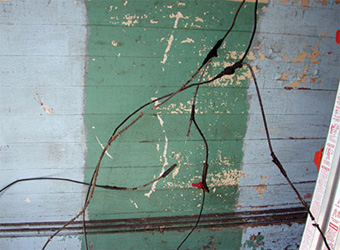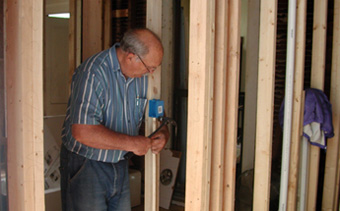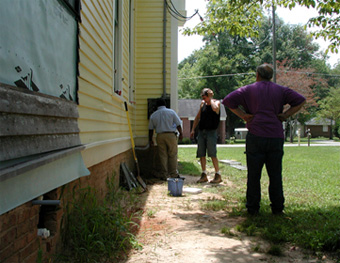
The old power meter was still attached to the outside of the house, so the building inspector allowed us to hook up one duplex outlet through the old fusebox. All the old aluminum electrical wires were nailed to the wall and painted blue.
|

This old wiring was found in the kitchen ceiling.
|

Our new power panel is on the right. Since the house was built before electricity was available, the location of any wiring and the fuse box was based strictly on accessibility. The original fusebox was attached to the kitchen wall nearest the meter on the outside of the house. None of the wiring coming out of the box was in conduit. The building inspector told us we needed to bring the wiring up to code. We were already thinking that after our first look at the wiring before we purchased the house.
Our new power panel was placed where it would be more centered to all the loads. This move would minimize the amount of wire we needed. We also wanted a place to "hide" the panel. It is mounted at eye-level and there is a building code requirement for proper height and location.
|
Running a line from the old fusebox to the new panel. This allowed us to check our new wiring such as lights to ensure we had things like 3-way switches connected properly.
|

We made a story-stick marked with heights for switch boxes, outlets and also height along the wall where we would drill through studs to pull wires. Much easier that measuring every location, and had the added benefit of a little shelf to hold the box while it was being nailed to the stud.
|

We had to drive two copper grounding rods into the ground six-feet apart. After we drove the grounding rods into the ground with our sledge hammer, we found out the electrician had a power tool that would have done it in a fraction of the effort which Jim expended. It was tough holding the rod with one hand and swinging a 10-pound sledge hammer with the other.
|

Friday morning bright and early Georgia Power came and disconnected us from the grid. This was the same power employee that had covered our power supply line with an insulator when we painted the gable end.
|

The electrician was delayed, so we began doing the parts of the connection we felt comfortable doing. Here Jim climbs the ladder to push the new supply line into the conduit. The carpet on the ladder protected Elizabeth's new paint job.
|

Hmmmm. Wonder what wire goes there?
|

The real electrician torques the connection.
|

The city building Inspector gives his stamp of approval. This is required before Georgia Power would reconnect our service. Although not necessary, the inspector felt more comfortable with the job knowing that a real electrician had made the final connection and looked at work we accomplished ourselves.
|

Back on the grid again. Georgia Power connects to our new cobra head.
|

This is our new power main shut off and meter base. PVC conduit now protects new wires. Our old meter was reinstalled. In a year and a half we hadn't use a full kilowatt of power.
|
|
|